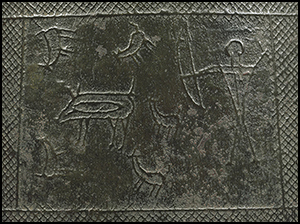Crossref Citations
This article has been cited by the following publications. This list is generated based on data provided by
Crossref.
Morey, Darcy F.
and
Jeger, Rujana
2017.
From wolf to dog: Late Pleistocene ecological dynamics, altered trophic strategies, and shifting human perceptions.
Historical Biology,
Vol. 29,
Issue. 7,
p.
895.
Lupo, Karen D.
2017.
When and where do dogs improve hunting productivity? The empirical record and some implications for early Upper Paleolithic prey acquisition.
Journal of Anthropological Archaeology,
Vol. 47,
Issue. ,
p.
139.
Guagnin, Maria
Perri, Angela R.
and
Petraglia, Michael D.
2018.
Pre-Neolithic evidence for dog-assisted hunting strategies in Arabia.
Journal of Anthropological Archaeology,
Vol. 49,
Issue. ,
p.
225.
Losey, Robert J.
Nomokonova, Tatiana
Fleming, Lacey S.
Kharinskii, Artur V.
Kovychev, Evgenii V.
Konstantinov, Mikhail V.
Diatchina, Natal'ia G.
Sablin, Mikhail V.
and
Iaroslavtseva, Larisa G.
2018.
Buried, eaten, sacrificed: Archaeological dog remains from Trans-Baikal, Siberia.
Archaeological Research in Asia,
Vol. 16,
Issue. ,
p.
58.
Yeomans, Lisa
Martin, Louise
and
Richter, Tobias
2019.
Close companions: Early evidence for dogs in northeast Jordan and the potential impact of new hunting methods.
Journal of Anthropological Archaeology,
Vol. 53,
Issue. ,
p.
161.
Perri, Angela
Widga, Chris
Lawler, Dennis
Martin, Terrance
Loebel, Thomas
Farnsworth, Kenneth
Kohn, Luci
and
Buenger, Brent
2019.
NEW EVIDENCE OF THE EARLIEST DOMESTIC DOGS IN THE AMERICAS.
American Antiquity,
Vol. 84,
Issue. 1,
p.
68.
Chambers, Jaime
Quinlan, Marsha B.
Evans, Alexis
and
Quinlan, Robert J.
2020.
Dog-Human Coevolution: Cross-Cultural Analysis of Multiple Hypotheses.
Journal of Ethnobiology,
Vol. 40,
Issue. 4,
p.
414.
Koungoulos, Loukas
and
Fillios, Melanie
2020.
Hunting dogs down under? On the Aboriginal use of tame dingoes in dietary game acquisition and its relevance to Australian prehistory.
Journal of Anthropological Archaeology,
Vol. 58,
Issue. ,
p.
101146.
Zhang, Yunan
Zhang, Dong
Yang, Yingliang
and
Wu, Xiaohong
2020.
Pollen and lipid analysis of coprolites from Yuhuicun and Houtieying, China: Implications for human habitats and diets.
Journal of Archaeological Science: Reports,
Vol. 29,
Issue. ,
p.
102135.
Cabral, Francisco Giugliano de Souza
and
Savalli, Carine
2020.
Sobre a relação humano-cão.
Psicologia USP,
Vol. 31,
Issue. ,
Hudson, Mark J.
Bausch, Ilona R.
Robbeets, Martine
Li, Tao
White, J. Alyssa
and
Gilaizeau, Linda
2021.
Bronze Age Globalisation and Eurasian Impacts on Later Jōmon Social Change.
Journal of World Prehistory,
Vol. 34,
Issue. 2,
p.
121.
Fish, Frank E.
Sheehan, Maura J.
Adams, Danielle S.
Tennett, Kelsey A.
and
Gough, William T.
2021.
A 60:40 split: Differential mass support in dogs.
The Anatomical Record,
Vol. 304,
Issue. 1,
p.
78.
Benítez-Burraco, Antonio
Pörtl, Daniela
and
Jung, Christoph
2021.
Did Dog Domestication Contribute to Language Evolution?.
Frontiers in Psychology,
Vol. 12,
Issue. ,
Pillay, Patricia
Allen, Melinda
and
Littleton, Judith
2021.
Canine Companions or Competitors? A Multi-Proxy Assessment of Human-Dog Competition.
SSRN Electronic Journal,
Venanzi, Lucio González
Prevosti, Francisco Juan
San Román, Manuel
and
Reyes, Omar
2021.
The dog of Los Chonos: First pre‐Hispanic record in western Patagonia (~43° to 47°S, Chile).
International Journal of Osteoarchaeology,
Vol. 31,
Issue. 6,
p.
1095.
Pfaller-Sadovsky, Nicole
and
Hurtado-Parrado, Camilo
2021.
A cultural selection analysis of human-dog interactions – A primer.
European Journal of Behavior Analysis,
Vol. 22,
Issue. 2,
p.
248.
Pillay, Patricia
Allen, Melinda S.
and
Littleton, Judith
2022.
Canine companions or competitors? A multi-proxy analysis of dog-human competition.
Journal of Archaeological Science,
Vol. 139,
Issue. ,
p.
105556.
Komatsu, Aya
Cooper, Elisabeth J.
Alsos, Inger G.
and
Brown, Antony G.
2022.
Towards a Jōmon food database: construction, analysis and implications for Hokkaido and the Ryukyu Islands, Japan.
World Archaeology,
Vol. 54,
Issue. 3,
p.
390.
Burza, Laura Brochini
Bloom, Tina
Trindade, Pedro Henrique Esteves
Friedman, Harris
and
Otta, Emma
2022.
Reading emotions in Dogs’ eyes and Dogs’ faces.
Behavioural Processes,
Vol. 202,
Issue. ,
p.
104752.
Carder, Nanny
Crock, John G.
and
Pinto, Audra
2023.
What can osteometric analyses tell us about domestic dogs recovered from a multicomponent indigenous site in Vermont?.
International Journal of Osteoarchaeology,
Vol. 33,
Issue. 2,
p.
196.



